The choice of material for finishing the facade of a private house is far from the easiest task. It is necessary to choose a cladding that meets such criteria as showiness, representativeness, beauty and durability. At the same time, I want to save on purchases, and subsequently not spend a lot of time and effort on surface maintenance. Fiber cement siding meets these requirements.
What is fiber cement siding or panels
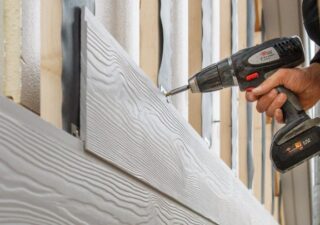
Fiber cement siding is a pressed panel consisting of cement, reinforcing fibers, sand and polymer fillers. Products are on sale in the form of elongated lamellas under a log (timber) or rectangular slabs imitating various materials.
Manufacturers offer the following models of fiber cement finishes:
- smooth sanded on one or both sides;
- with through impregnation;
- with a surface covered with natural stone chips.
- with a polyurethane coating from ultraviolet radiation;
- with a surface imitating brickwork, textured plaster, natural stone.
During the manufacturing process, the panels are embossed or polished, depending on the specified conditions of the final parameters.
Fiber cement siding characteristics
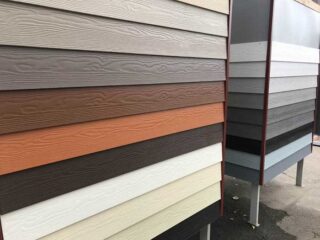
The modern industry produces a huge amount of interesting and inexpensive finishing materials, among which the leading position is taken by fiber cement.
Its popularity is based on such positive characteristics:
- high strength;
- resistance to temperature changes;
- waterproofness;
- very low hygroscopicity;
- frost resistance;
- immunity to chemically active substances;
- good sound insulation;
- mold and insects do not start in the stoves;
- incombustibility;
- ease of processing and installation.
There are two drawbacks. The first is high weight, which is a derivative of the strength condition. The second is a nondescript and boring gray surface. This disadvantage can be easily eliminated by applying acrylic paint. The surfaces themselves have already been primed.
Leading brands of fiber cement siding
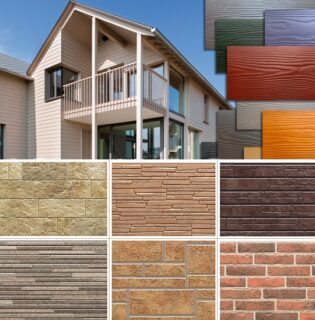
The finishing technology is not very complex, therefore it is well mastered by foreign and domestic manufacturers.
To date, the following brands are considered the best:
- Decover (Russia);
- Cedral (Belgium);
- Nichiha (Japan);
- Latonite (Russia);
- Rospan (Russia).
The panels are sold painted, primed or untreated. The buyer himself determines what he needs, based on the intended area of use of the decoration and the style of the room.
Scope of fiber cement siding
The scope of application of fiber cement panels is limited only by the imagination and tastes of the property owners. The material can be used in both private and commercial construction.
Slabs are great for cladding such properties:
- private houses and summer cottages;
- baths;
- garages;
- cornices;
- plinths;
- fences;
- towers;
- industrial buildings and offices.
The material is in demand due to the excellent combination of protective and aesthetic properties, the optimal combination of price and quality.The frame type of fastening allows the use of thermal insulation.
Independent or professional execution
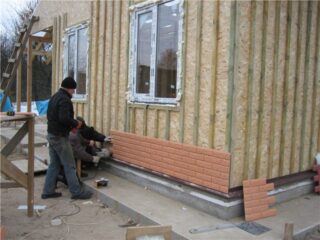
Any construction involves high financial costs. Many craftsmen want to save money at any cost, including making plates with their own hands. There is a certain reason for this, since self-production will cost much less, the price of the final product will not include the cost of wages for workers, administrative staff, sellers, transportation, and rental of commercial premises.
This is where the advantages of this approach end. You need fibers, polymer additives, molds, equipment and knowledge of production technology. In the absence of such components, you can not count on a high-quality end result. The properties of homemade panels will be far from factory counterparts, and they will not last long. Therefore, it is better to spend money, but install a finish that is really worthwhile in all respects.
Tools and materials
To mount the siding, a standard set of household tools is enough.
For work you will need:
- puncher;
- Bulgarian;
- jigsaw;
- roulette;
- a hammer;
- level;
- screwdriver;
- paint brush.
List of materials:
- panels in the estimated amount;
- additional elements;
- strip strips;
- protective paint;
- sealant;
- galvanized roofing nails.
Since you will have to fix it at a height, you need to take care of a stable ladder. Work must be carried out in protective equipment - helmet, respirator, goggles and gloves.
Fiber cement siding installation technology
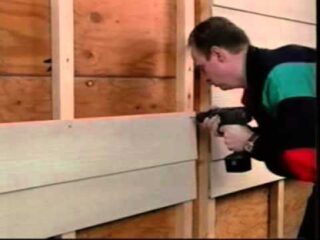
Installation of fiber cement siding can be carried out in vertical and horizontal orientation. The instructions attached to the product will help you to do the job accurately and without errors.
Cladding installation sequence:
- Apply markings. Mark points and drill holes for the frame on them.
- Treat the base with an antiseptic, and if it is a tree, then also with a fire retardant.
- Secure the frame. For buildings made of bricks and foam blocks, it is better to take a steel profile, and for timber and logs - wooden slats, previously dried and impregnated with a primer.
- Attach insulation. For this, glue, iron or plastic dowels are used.
- Nail in the membrane sheet. It is used only when installing ventilated facades.
- Sheathe the frame with waterproof plywood or OSB. Leave expansion joints 2 mm, which are filled with sealant. Fastening can be done with nails or self-tapping screws.
- Screw on the starter bar. It is set at the level of the upper part of the base or 2-3 cm above the blind area.
The panels can be fastened with nails end-to-end, overlay, or a locking mechanism is used. The choice is made depending on the panel model and the priorities of the owners.
Finishing of the facing material
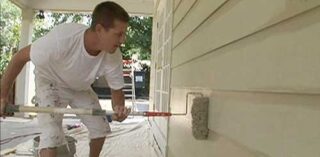
This procedure is carried out in order to give the finish additional protective properties or the desired color. It should be carried out after installation, as during this process the plates can be scratched. For adherents of a natural shade, it is better to choose a colorless varnish.
Acrylic paint is chosen, as it has the most optimal performance characteristics. The application of the compositions is carried out with a spray gun, roller, brush with the capture of the end parts. Several layers are made with the time intervals necessary for their drying.








